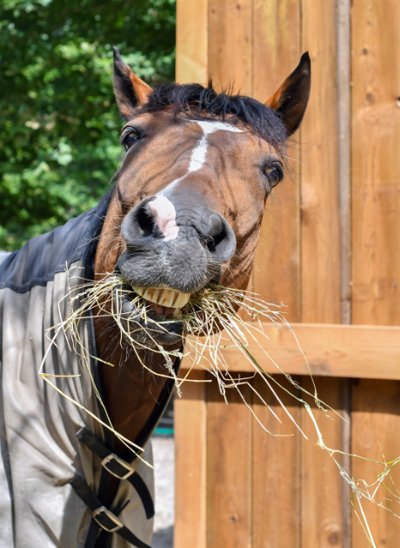Hay is the largest part of a horse's diet. A horse needs 20 to 30 pounds of hay per day and high-quality hay can provide horses with ample nutrition. The horse's body consumption depends on its age, daily workload, etc.
Hay is usually divided into grasses and leguminous hay. The protein, vitamins, carbohydrates, fats, calcium, etc. of grasses are slightly lower than that of leguminous hay. However, it's not advisable to exclusively feed legume hay due to its high calcium content, which can lead to urinary issues in horses. Horses spend approximately 16 hours each day foraging, and their health depends on their food choices. Therefore, selecting the right hay is crucial.
 | 1. Timothy Hay: One of the most popular hay in the United States and Canada, it's rich in protein but lacks some minerals. |
| 2. Bermuda Grass Hay: Predominantly found in the southern United States, it contains around 10% protein and most essential amino acids, but vitamins need to be supplemented. It lacks selenium and other trace minerals. | |
| 3. Orchard Grass Hay: Commonly grown in the Midwest and Eastern United States and horses generally have a lower preference for it. If the moisture content of this hay is too high, it will become moldy. Please note that it also lacks some trace minerals. | |
| 4. Alfalfa Hay: With a protein content of around 20%, it's rich in nutrients such as calcium, iron, and zinc. And it's a good choice for highly active horses. The Alfalfa Hay tastes delicious, which can cause horses to overeat and lead to issues like colic or indigestion. | |
| 5. Clover Hay: Protein content ranges from 15% to 20%, with abundant nutrients including iron, manganese, and potassium. High in calcium but low in phosphorus. Please be aware that clover hay is susceptible to mold. | |
| 6. Cereal hay is mostly made from oats, barley and rye, with protein content ranging from 10% to 20%. It should be noted that if grain hay is exposed to cold weather or drought conditions before being baled, it may contain high concentrations of potassium permanganate, which can cause horse toxicity. In this case, it is recommended to submit it to the laboratory for examination first. |

1. When checking hay, it is recommended to open one or more bales for inspection.Minor discoloration on the exterior is normal and shouldn't be a cause for concern.
2. Try to choose hay that feels soft to the touch, has abundant green leaves and slender stems.
3. Avoid feeding hay that has been pickled, excessively sun-dried, or bleached. If you notice a moldy or fermented sour smell, stop feeding immediately.
4. Don’t choose hay mixed with a lot of dirt, debris or other particles.
5. Check if the hay has been infested with insects or carries pathogens.
6. If the hay feels warm or is heavier than usual, it may contain excess moisture, which can lead to mold formation.
7. Ideally, feed all purchased hay within a year to prevent nutrient loss.
8. If you want to preserve hay, it is best to place it in a dry and sheltered place to avoid exposure to harsh weather conditions.
9. If you want to buy in large quantities, it is recommended to consult experts or nutritionists for dietary assessments, as horses of different ages have varying nutritional requirements.